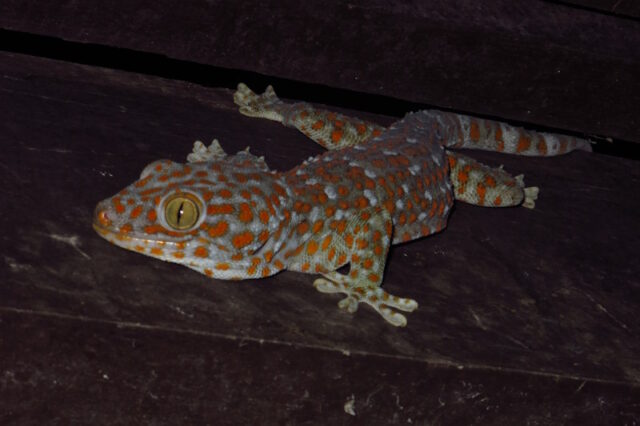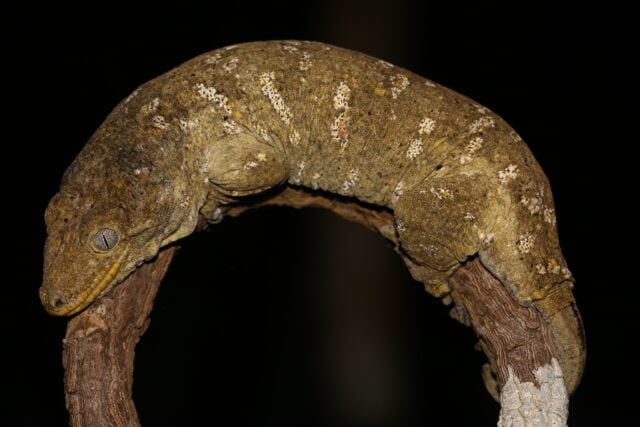Greetings, fellow reptile enthusiasts! If you’re considering bringing a new scaly friend into your life, you might be torn between a couple of fascinating species – the Tokay Gecko and the New Caledonian Giant Gecko. It’s a tough choice to make – both are captivating creatures, each with its own unique charm. But don’t fret; we’re here to help make your decision a little easier.
This article is meant to guide you through the essential aspects of these two species. We’ll dive into their backgrounds, explore their habitats, and shed some light on their personalities. We’ll also delve into their care needs, helping you understand what each one requires in terms of housing, diet, and health. It’s all about assisting you in making an informed choice that aligns with your lifestyle, resources, and personal preferences.
Background Information on Tokay Geckos
Native to Southeast Asia, Tokay Geckos (Gekko gecko) are a nocturnal species widely recognized for their striking appearance and distinctive vocalizations. In the wild, they inhabit a variety of environments ranging from forests to urban areas. These geckos are known for their adaptability, thriving in both tropical and subtropical climates. Physical Characteristics: When it comes to looks, Tokay Geckos are true standouts. Sporting a vibrant blue or grey body adorned with red or orange spots, these creatures are as visually captivating as they are intriguing. Adults typically reach lengths of 10 to 15 inches, with males being slightly larger than females.
They also feature flattened bodies, large eyes perfect for nocturnal activity, and powerful jaws that they’re not afraid to use if threatened. Lifespan and Maturity: In captivity, Tokay Geckos can live for 10 to 20 years, given proper care. They reach sexual maturity between 1 to 2 years of age. With such a long lifespan, owning a Tokay Gecko is quite a commitment, so keep this in mind when considering this species as a pet.
Background Information on New Caledonian Giant Geckos
New Caledonian Giant Geckos, or Rhacodactylus leachianus, come from the South Pacific, specifically New Caledonia. This island locale has a unique blend of rainforests and coastal regions, shaping the gecko’s habits and physiology. New Caledonian Giant Geckos are also mostly nocturnal, though they can occasionally venture out during the day. Physically, these geckos are imposing. They are the largest gecko species in the world, with adults often reaching a length of up to 17 inches. Their skin is a mosaic of grays, browns, and greens, which help them blend into their environment.
One of the most distinctive features of the New Caledonian Giant Gecko is its eyes: large, expressive, and spanning a range of beautiful colors. In terms of lifespan, the New Caledonian Giant Gecko is a long-term companion. They can live for up to 20 years in captivity, with some even reported to exceed this age. Like the Tokay Gecko, they reach sexual maturity around 2 years of age. Owning a New Caledonian Giant Gecko is a long-term commitment and something to consider when choosing your reptile companion.
Caring for Tokay Geckos: Needs and Challenges
The care needs of the Tokay Gecko are significant but manageable if you’re armed with the right knowledge. Housing and Environment Requirements: Tokay Geckos need a sizable vertical space as they love to climb. A terrarium or a large vivarium that allows them to express their natural climbing behavior is best. The temperature should mimic their tropical natural habitat, with a gradient ranging from 75 to 90 degrees Fahrenheit.
Humidity is also crucial, and it should stay between 60-80%. Proper ventilation is necessary to prevent respiratory issues. Dietary Needs: Tokay Geckos are insectivores. Their diet should primarily consist of a variety of insects, including crickets, mealworms, roaches, and occasionally small mice. The food should be appropriately sized, generally no larger than the width of the gecko’s head. Calcium and vitamin supplements are also essential for maintaining their health. Health Considerations and Common Issues: With proper care, Tokay Geckos are generally hardy creatures.
However, they can suffer from common reptile health issues like metabolic bone disease, parasitic infections, and respiratory problems. Regular vet check-ups are advised to ensure your pet is in optimal health. Social Behavior and Temperament: Tokay Geckos are renowned for their aggressive temperament. They are solitary creatures and are best kept alone. They can be challenging for beginners due to their feisty behavior and aren’t too fond of being handled. Hence, they may not provide the interactive pet experience that some owners seek.

Caring for New Caledonian Giant Geckos: Needs and Challenges
If you’re drawn to the New Caledonian Giant Gecko, it’s essential to understand what their care involves.
Housing and Environment Requirements: New Caledonian Giant Geckos, like their Tokay counterparts, require an enclosure with vertical space for climbing. The temperature should be slightly cooler, with an optimal range between 70 to 78 degrees Fahrenheit. Humidity should stay consistent, hovering between 60-80%. Make sure to provide plenty of foliage and hiding spaces to mimic their natural environment and make them feel secure.
Dietary Needs: These geckos are omnivorous, their diet consists of both plant and animal matter. A combination of fruits, insects, and commercial gecko diet provides balanced nutrition. Ensure that all food items are small enough to prevent choking hazards. Supplements with calcium and vitamins are essential for their well-being.
Health Considerations and Common Issues: New Caledonian Giant Geckos are generally robust, but they can still suffer from conditions like metabolic bone disease and parasitic infections. Regular fecal checks can help keep parasites at bay, and maintaining the correct dietary and environmental conditions can prevent many health issues.
Social Behavior and Temperament: Compared to the Tokay Geckos, New Caledonian Giant Geckos have a gentler temperament. They tolerate handling better, but they’re not overly social animals and may require some time to acclimate to regular interactions. They are not typically aggressive and are generally more suitable for beginners or families. After exploring the needs and challenges of both species, it’s time to analyze them side by side. This comparative analysis will provide a clearer picture of which gecko might be the right fit for your lifestyle. 
Comparative Analysis: Tokay Gecko vs New Caledonian Giant Gecko
After delving into each gecko’s background and care needs, it’s time to examine them in comparison. This analysis will aid in deciding which gecko aligns best with your expectations and capabilities.
Care Requirements: Both geckos require a similar environment — a spacious, vertical enclosure, maintaining tropical temperatures and high humidity. However, New Caledonian Giant Geckos thrive at slightly cooler temperatures than Tokay Geckos. Regarding dietary needs, New Caledonians have a more varied diet as they are omnivorous, eating both plant and animal matter, while Tokay Geckos primarily consume insects.
Behavior and Temperament: The Tokay Gecko is known for its aggressive behavior, making it a less desirable choice for those seeking a pet for handling and interaction. Conversely, the New Caledonian Giant Gecko is more docile and tolerates handling better, making it more suitable for beginners or those seeking a more interactive pet experience.
Longevity and Health Issues: Both geckos can live up to 20 years in captivity, meaning either choice is a long-term commitment. They share common potential health issues such as metabolic bone disease and parasitic infections, indicating that diligent care is necessary, regardless of the species you choose.
Practical Considerations: For those who prefer a hands-off, observational pet, the Tokay Gecko may be a good choice due to its solitary and aggressive nature. However, if you’re a novice herpetologist or seeking a reptile that tolerates handling, the New Caledonian Giant Gecko would be a better option. Size is also a consideration; if space is an issue, the slightly smaller Tokay Gecko could be a better fit.
Conclusion
Choosing between a Tokay Gecko and a New Caledonian Giant Gecko for a pet is no small decision. Both these species offer a unique and enriching pet experience, albeit quite different in nature. The vivacious and somewhat intimidating Tokay Gecko is a fascinating creature, but it might be a handful for those new to reptile care. On the other hand, the gentle, intriguing New Caledonian Giant Gecko could be a better fit for beginners or those looking for a more interactive pet, albeit they need a slightly cooler environment and a more diverse diet. Ultimately, it’s all about aligning your choice with your lifestyle, preferences, and readiness to meet the species-specific needs of these creatures. Remember, both these geckos live for a long time and require dedicated care, so whichever you choose, you’re in for an engaging, long-term journey. Here’s to finding the perfect reptilian companion for your home!
FAQs
Are Tokay Geckos good pets for beginners?
While Tokay Geckos are fascinating creatures, their aggressive temperament can make them challenging for beginners. They’re best suited for more experienced herpetologists.
Can New Caledonian Giant Geckos be handled?
Yes, New Caledonian Giant Geckos tolerate handling better than many other gecko species. However, it’s essential to handle them gently and not too frequently to avoid causing them undue stress.
What do Tokay Geckos eat?
Tokay Geckos primarily eat insects, including crickets, mealworms, and roaches. Occasionally, they can also consume small mice.
What is the lifespan of a New Caledonian Giant Gecko?
New Caledonian Giant Geckos can live up to 20 years or more in captivity with proper care.
Can Tokay Geckos live together?
Tokay Geckos are solitary creatures and generally do better when housed individually. Cohabitation may lead to territorial disputes and stress.
How big do New Caledonian Giant Geckos get?
New Caledonian Giant Geckos are the largest gecko species. Adults can reach up to 17 inches in length.
Do Tokay Geckos need a heat lamp?
Yes, Tokay Geckos need a heat gradient in their enclosure to mimic their natural tropical environment. A heat lamp is an effective way to provide this.
What should I feed my New Caledonian Giant Gecko?
New Caledonian Giant Geckos are omnivores. A diet consisting of fruit, insects, and commercial gecko diet is generally recommended.
Are Tokay Geckos aggressive?
Tokay Geckos are known for their aggressive nature. They can be defensive and are not fond of being handled.
Are New Caledonian Giant Geckos good for families?
Given their gentle temperament and tolerance for handling, New Caledonian Giant Geckos can be a good choice for families or beginner pet owners. However, all interactions with younger children should be supervised to ensure gentle handling.